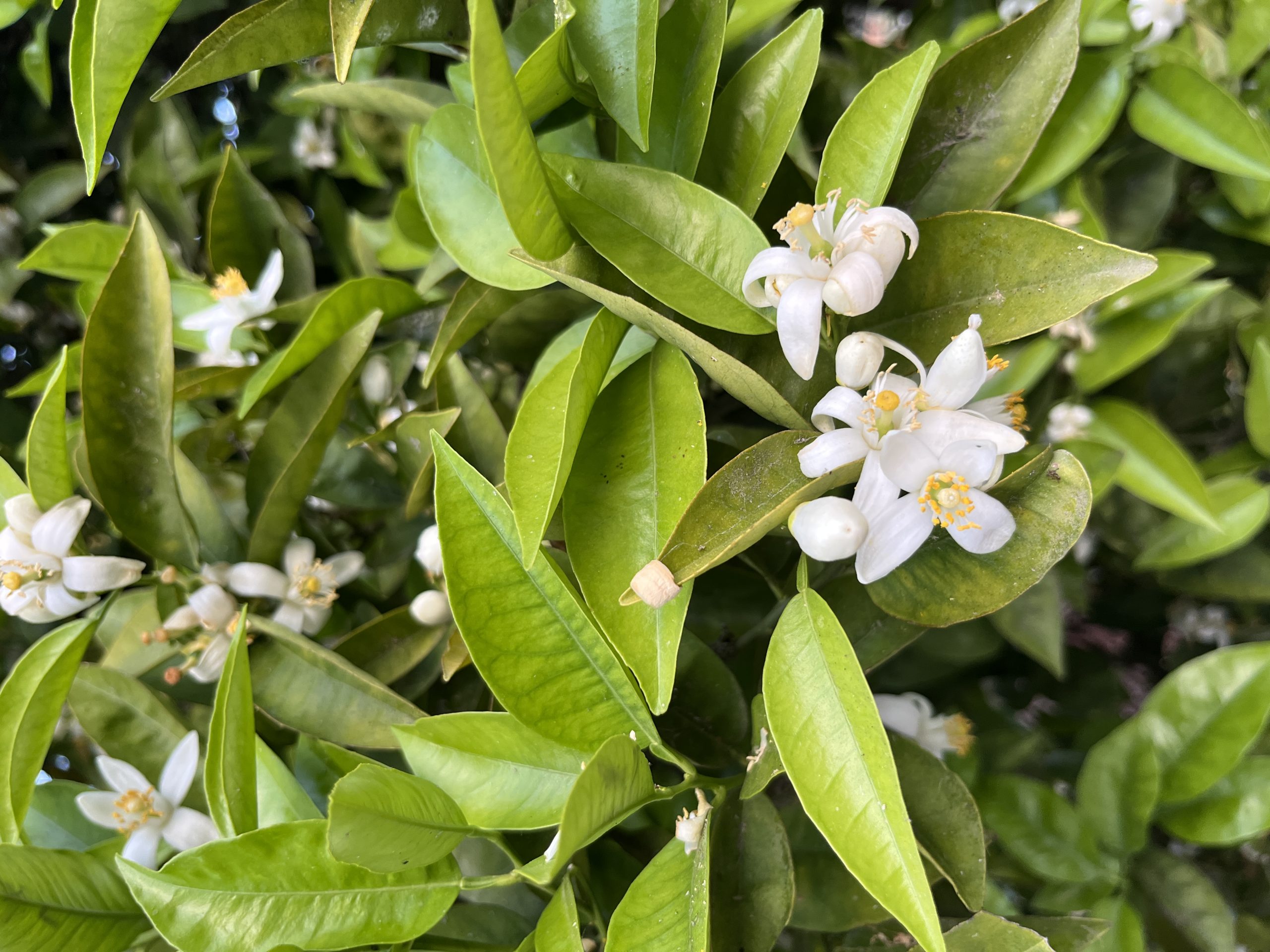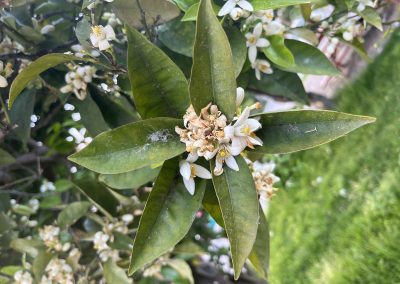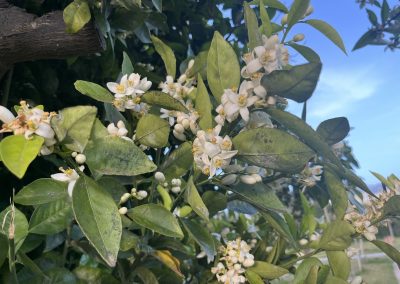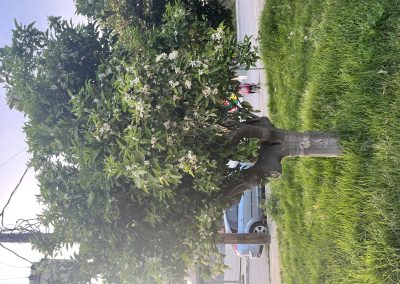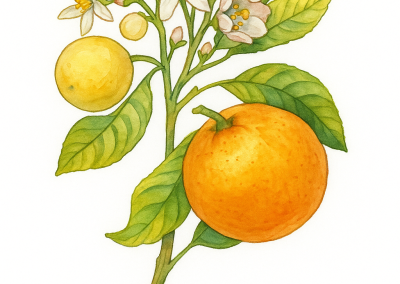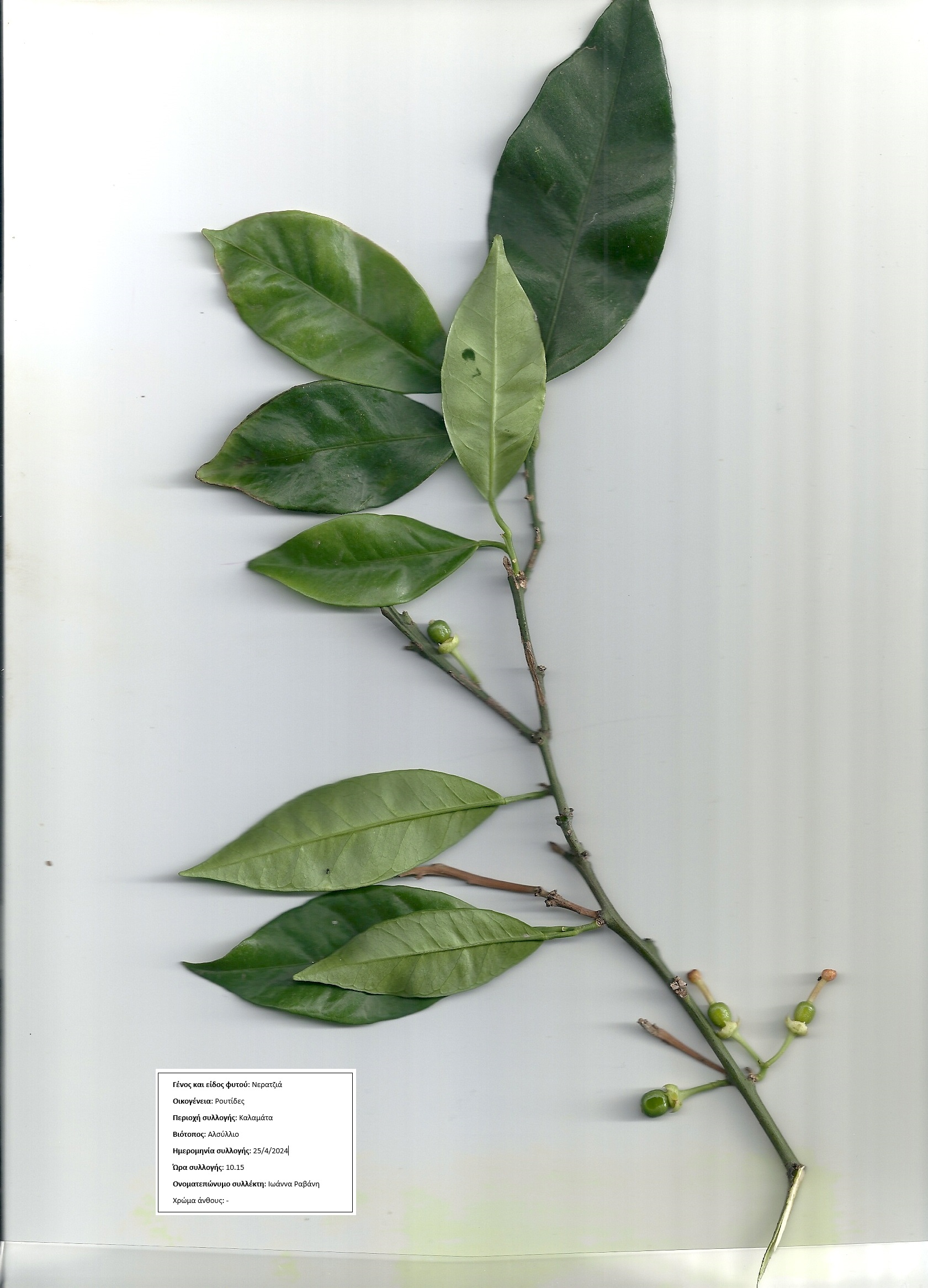Citrus aurantium
Scientific description
Scientific name: Citrus aurantium
Common name: Bitter orange, Seville orange
Kingdom: Plantae
Taxonomy: Angiosperms, Eudicots, Rosids
Order: Sapindales
Family: Rutaceae
Genus: Citrus
Species: Citrus aurantium
Origin:
Southeast Asia. Planted for dense foliage and decorative, large spherical orange fruits. Common in Mediterranean gardens, streets, sidewalks, and house yards.
Ecology:
In Greece, widely used as rootstock for orange, lemon, and tangerine due to cold and drought resistance. Suitable for urban/country gardens, Mediterranean orchards, pots, balconies, sunny interiors, alone or with smaller plants.
Description:
Fruitful citrus tree, 4–8 m tall, 2.5–4 m wide, maturing in 10–20 years. Dark green, glossy leaves give a shrubby shape and aromatic scent. Flowers are white, star-shaped with golden yellow centers, appearing spring to early summer. Edible orange fruits follow, sour and slightly bitter.
Propagation:
Budding or vegetative propagation. Stem cutting is the main method for young trees.
Usage:
Leaves and flowers used as decoction: antispasmodic, digestive, calming, insomnia relief, stomachache, cough, blood sugar control. Flowers produce essential oil (neroli) with antidepressant, antiseptic, antispasmodic, anti-aging, aphrodisiac, sedative properties. Cosmetic uses: skin renewal, hair rinse, creams. Rich in antioxidants, vitamin C, and flavones, improving microcirculation and reducing cellulite.
Επιστημονική ονομασία: Citrus aurantium
Κοινή ονομασία: Νεραντζιά, πορτοκάλι Σεβίλλης
Βασίλειο: Φυτά (Plantae)
Συνομοταξία: Αγγειόσπερμα, Δικοτυλήδονα, Ροδίδες
Τάξη: Σαπινδώδη (Sapindales)
Οικογένεια: Ρουτίδες (Rutaceae)
Γένος: Citrus
Είδος: Citrus aurantium
Καταγωγή:
Νοτιοανατολική Ασία. Καλλιεργείται για πυκνό φύλλωμα και διακοσμητικούς πορτοκαλί καρπούς. Χρησιμοποιείται σε δρόμους, πεζοδρόμια, αυλές και σε Μεσογειακούς κήπους.
Οικολογία:
Στην Ελλάδα χρησιμοποιείται συχνά ως υποκείμενο για εμβολιασμό πορτοκαλιών, λεμονιών και μανταρινιών λόγω αντοχής σε ψύχος και ξηρασία. Κατάλληλη για αστικούς και εξοχικούς κήπους, οπωρώνες, γλάστρες, μπαλκόνια και ηλιόλουστα εσωτερικά.
Περιγραφή:
Καρποφόρο εσπεριδοειδές, ύψος 4–8 μ., πλάτος 2,5–4 μ., αναπτύσσεται σε 10–20 χρόνια. Λαμπερά σκούρα πράσινα φύλλα, αρωματικά. Άνθη λευκά, σχήμα αστεριού με κίτρινο κέντρο, την άνοιξη έως αρχές καλοκαιριού. Ακολουθούν βρώσιμοι πορτοκαλί καρποί με ξινή και ελαφρά πικρή γεύση.
Πολλαπλασιασμός:
Εκβλάστηση ή βλαστικός πολλαπλασιασμός. Η κοπή βλαστού είναι η κύρια μέθοδος.
Χρήση:
Φύλλα και άνθη: σπασμολυτικά, χωνευτικά, ηρεμιστικά, για αϋπνία, στομαχόπονο, βήχα, ρύθμιση σακχάρου. Ανθές: νερόλι, αιθέριο έλαιο με πολλαπλές ιδιότητες. Καλλυντική χρήση: ανανέωση δέρματος, ξέπλυμα μαλλιών, κρέμες προσώπου. Πλούσιο σε αντιοξειδωτικά, βιταμίνη C και φλαβόνες, βελτίωση μικροκυκλοφορίας, μείωση κυτταρίτιδας.
Nom scientifique : Citrus aurantium
Nom commun : Orange amère, Orange de Séville
Règne : Plantes (Plantae)
Taxonomie : Angiospermes, Eudicots, Rosidés
Ordre : Sapindales
Famille : Rutaceae
Genre : Citrus
Espèce : Citrus aurantium
Origine :
Asie du sud-est. Planté pour feuillage dense et fruits orange sphériques décoratifs. Utilisé dans les rues, trottoirs, cours et jardins méditerranéens.
Écologie :
En Grèce, très courant comme porte-greffe pour oranges, citrons et mandarines (résistant au froid et à la sécheresse). Convient aux jardins urbains/campagnards, vergers méditerranéens, pots, balcons, intérieurs ensoleillés, seul ou avec d’autres plantes.
Description :
Agrume productif, 4–8 m de hauteur, 2,5–4 m de largeur, croissance en 10–20 ans. Feuillage vert foncé brillant, aromatique. Fleurs blanches étoilées avec centre jaune doré, printemps à début été. Fruits oranges comestibles, acides et légèrement amers.
Multiplication :
Ébourgeonnage ou multiplication végétative. Bouturage des tiges pour jeunes arbres.
Usage :
Feuilles et fleurs en décoction: antispasmodique, digestif, calmant, insomniaque, maux d’estomac, toux, régulation glycémie. Fleurs: huile essentielle (néroli), propriétés variées. Cosmétique: renouvellement cutané, rinçage cheveux, crèmes visage. Riche en antioxydants, vitamine C, flavones, amélioration microcirculation et réduction cellulite.
Denumire științifică: Citrus aurantium
Denumire comună: Portocal amar, portocal de Sevilla
Regn: Plantae
Taxonomie: Angiosperme, Eudicotiledone, Roside
Ordin: Sapindales
Familie: Rutaceae
Gen: Citrus
Specie: Citrus aurantium
Origine:
Asia de Sud-Est. Plantat pentru frunziș dens și fructe portocalii mari, sferice. Folosit pe străzi, trotuare și în grădini mediteraneene.
Ecologie:
În Grecia, frecvent ca portaltoi pentru portocal, lămâi și mandarine, rezistent la frig și secetă. Potrivit pentru grădini urbane/rurale, livezi, ghivece mari, balcoane, interioare însorite, singur sau cu alte plante mici.
Descriere:
Citrus roditor, 4–8 m înălțime, 2,5–4 m lățime, creștere 10–20 ani. Frunze verde închis, lucioase, aromatice. Flori albe, în formă de stea, centru galben auriu, primăvara – începutul verii. Fructe portocalii comestibile, acre și ușor amare.
Înmulțire:
Înmugurire sau înmulțire vegetativă. Butașarea tulpinii metoda principală.
Utilizare:
Frunze și flori: antispastice, digestive, calmante, ajută la insomnie, dureri de stomac, tuse, scăderea glicemiei. Fiori: ulei esențial (neroli), proprietăți multiple. Cosmetic: reînnoire piele, clătire păr, creme față. Bogat în antioxidanți, vitamina C, flavone, microcirculație mai bună, reducere celulită.
Creative writing inspired by Citrus aurantium
Citrus aurantium
According to legend, Hera, the goddess of marriage and family, was the guardian of the orange trees. When she married Zeus, the Charites offered her a garden filled with these trees, located in the enchanting land of the Hesperides. The oranges, with their fragrant blossoms and vibrant, juicy fruit, became a symbol of fertility, joy, and love.
Hera lovingly tended to this garden, as the oranges were bittersweet, much like the relationships between mortals and gods. Each fruit represented the contradictions of life: joy and sorrow, love and pain. It was said that Hera would give oranges to women who desired to have children, as she considered them blessed.
Another legend tells that Heracles, during his eleventh labor, had to steal the golden apples of the Hesperides, which were in fact oranges. Heracles faced great trials to obtain them, demonstrating that the pursuit of true happiness requires effort and sacrifice.
The orange tree thus became a symbol of prosperity and abundance, but also of the complex nature of life, where sweetness and bitterness coexist in harmony.


